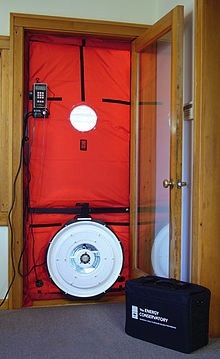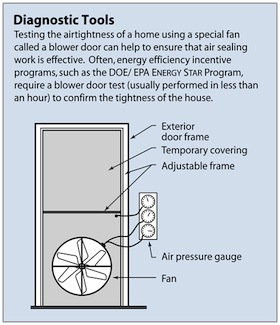Blower-Door Test
As the requirements for energy-efficiency in new homes become more and more stringent, builders and homeowners are relying more on energy audits to determine just how air-tight a home structure is.
Homes being built today are much more efficient and air-tight than older homes, but even the most efficient green homes can leak a lot of air. That air leakage results in higher energy costs, as air conditioners and furnaces work harder to keep the living spaces comfortable.
Air leakage from drafty walls, ceilings and windows can account for half of the heat loss in homes. Small gaps and cracks create air leakage that can be equal to leaving a window in the home open year round. The amount of energy needed to compensate for that much unwanted air leakage can be huge.
Air leakage leads to higher energy costs, but it can also be a major cause of moisture problems inside the home. Humid air leaking in during warm weather encourages unhealthy mold growth, and cold air leaking out of a house can damage exterior sheathings, and lead to mold growth there as well.
Setting a Standard for Home Air Leakage
Builders of new homes, and an increasing number of contractors doing home renovations, are turning to blower-door testing in order to get an accurate measurement on how much air leakage is occurring in a home.The 2012 International Energy Conservation Code (IECC) has set a new standard for air leakage: the maximum leakage is 1 ach (air changes per hour) in southern climates and 3 ach everywhere else, with a 50 Pascal air pressure difference between inside and outside the home. 50 Pascals (50p) of pressure is roughly equal to a 20 mph wind blowing across the home.
Blower-Door: Accuracy in Measurement
A blower-door test is the most accurate form of air-leakage measurement; it's also a fairly straightforward process. A large fan is placed in a frame, which fits into an exterior door opening. With all exterior doors and windows closed, and all interior doors opened, the fan sucks air out of the home until a pressure sensor reaches the 50p pressure difference between outdoors and indoors.The powerful vacuum effect of the fan pulls air into the home through any cracks or gaps in the building envelope. In only about two minutes, the amount of air flowing through the fan at the 50p pressure level is measured, determining the amount of air leakage.
Because the 50p pressure level is much higher than what a home normally experiences, air is sucked in through even the smallest of cracks and gaps at higher speeds. While this is occurring, it becomes possible to easily identify where these gaps are by using a handheld smoke pencil.
Where Air Leakage Occurs
In most houses, air leaks in the most around windows, doors, ceiling light receptacles, fireplaces….anywhere where there is an interruption in a wall or ceiling. By knowing exactly where the leakage is occurring, it becomes much easier to rectify the problem areas, leading to a direct drop in energy usage.In this era of greater focus on green building, blower-door testing is done with new homes, but also during an increasing number of remodels or renovations. They do an excellent job of identifying the source of drafts in older homes, and allows those problems to be easily fixed. Before and after blower-door tests can be performed to assess how successful an older homes' green remodel has been.
Blower-door tests are not cheap, usually between $200 and $350, but the savings that can result from filling gaps and cracks makes them a very worthwhile investment. The Residential Energy Services Network provides a list of certified blower-door testers; some local utility companies also offer blower-door tests and other energy audits to consumers, often at discounted rates.
Many builders and homeowners are shocked at the results of their blower-door tests; most gaps and cracks in a homes' envelope are tiny or invisible, but the leakage that results can be huge. A simple blower-door test can be a powerful tool in the quest for a super-efficient green home.
comments powered by Disqus




























































































































































































